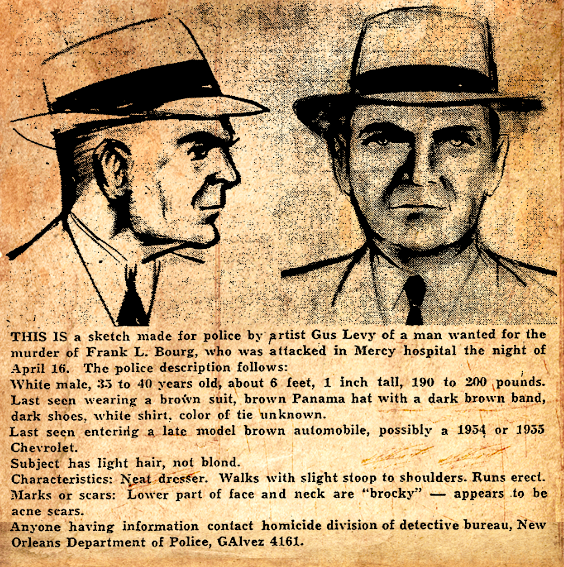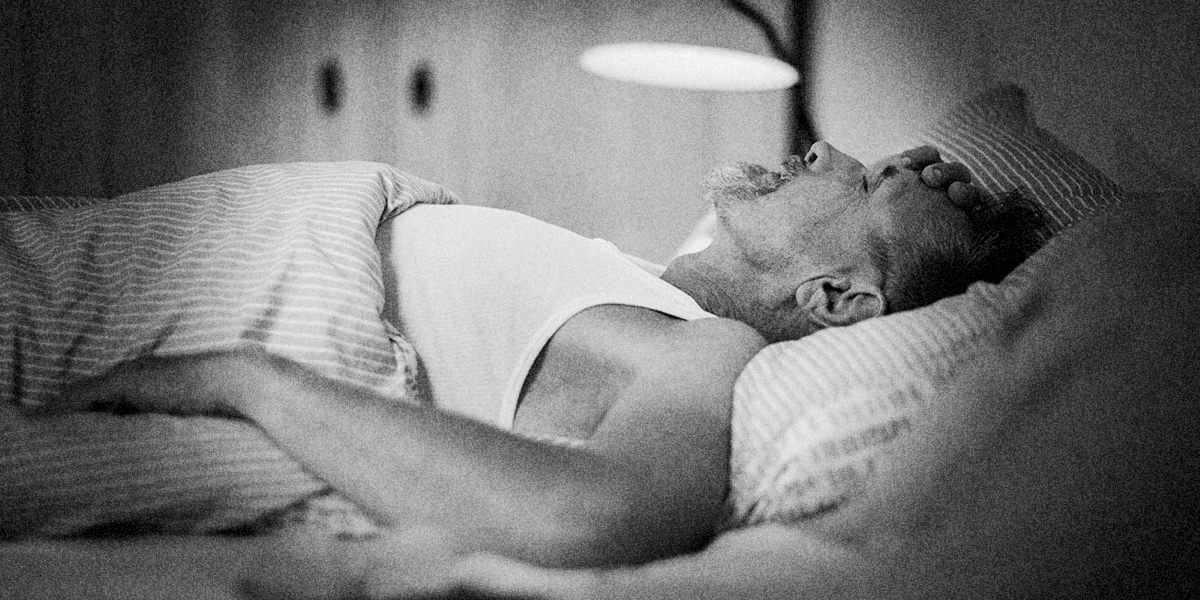Mercy Hospital killer unidentified 66 years later
On a Saturday night, just after nine, April 16, 1955, a man in a Panama hat stepped into a room on the cardiac ward of Mercy Hospital in New Orleans. Inside, he silently crushed a dozing patient’s head with a blunt instrument.
In the parking lot, investigators found a hatchet wrapped in a towel with the name of the hospital stamped in black ink. They also found the name of a hardware merchant etched into the tool’s handle. It read: Ponchatoula Feed and Seed.
Frank L. Bourg, the 64-year-old patient, underwent heart surgery one day earlier. His wife, “Jennie,” the former Eugenie Cazes, remained with him as he recovered. Before the attack, she had gone to the restroom next door to wash up for the night. Frank was dozing in and out of sleep when she left him, but as she removed her makeup, she heard the maid’s voice inside his room.
“Mr. Frank,” she called out, “Do you need anything?” Jennie heard the woman say, “Please tell your wife I will be back in five with fresh towels. I’ll be right back, Mr. Frank.”
Jennie did not hear her husband respond to the maid, but minutes later, she heard him scream, “Oh, my God!”
Running into the room, Jennie found her husband wheezing, his head bleeding and misshapen. Frank died five days later.
At a news conference following the autopsy, Dr. Nicholas J. Chetta, Orleans Parish coroner, spoke to reporters. “The death of Frank L. Bourg of 812 Friscoville, Arabi, is most definitely a homicide.”
Dr. Chetta said Frank, a senior teller at the Hibernia National Bank, died “because of blows about the head.” He did not elaborate on those injuries.
Homicide Captain William J. Dowie spoke next, saying his office had assigned all homicide teams to Frank’s case and the search for his killer. An alert had gone to surrounding parishes: Be on the lookout for a well-dressed man in brown, seen leaving Frank’s room following the attack.
Dowie said a hospital maid could identify the slayer. He said she remained at his disposal, through the co-operation of Captain Eugene Dakin, assistant supervisor of detectives, whose team guarded the maid around the clock. The other detective teams, he said, had distributed drawings based on the maid’s description and would “run down whatever clues needed checking.”

Captain Dowie said police sought a man between 35 and 40 years, approximately 6-foot-1 inches tall, weighing between 190 and 200 pounds. Five witnesses at the hospital said he wore a dark brown suit and a brown Panama hat with a darker brown band. He left the hospital in a dark brown late model car. Dowie said the hospital maid, whose identity he kept secret, stood ready to identify the man after his capture.
In Tangipahoa Parish, the Hammond Police Department received reports from a pilot at the Hammond Airport. After seeing the distributed drawing in the newspaper, he remembered watching the suspect board a small plane that Sunday morning, April 17.
The assailant, Dowie said, beat Frank “about the head with a short blunt instrument like a blackjack or gun-butt.” Another week passed before Wilson Bourg, one of Frank’s five brothers, told reporters of police finding the hatchet with the Ponchatoula Feed and Seed inscription.
Asked about a motive, Captain Dowie refused to speculate whether the attack was a case of mistaken identity. Another heart patient, Ashton J. Charree, 8013 Panola, shared the room with Frank Bourg. A curtain, Dowie confirmed, separated the two patients and hid Ashton Charree from the assailant’s view.
Mistaken identity, most agreed, was the most likely motive.
Frank’s fellow bank employees described him as a quiet-spoken individual who led a quiet life, devoting his spare time to home and family. Jennie told police Frank planned to retire after his release from the hospital. A clerk at Hibernia National Bank for 45 years, he started work on April 10, 1910.
Just before Christmas 1954, Frank injured his foot in a stuck elevator and, for the first time in his career, missed four weeks of work. He returned to work and three weeks later contracted influenza. One month after that, he suffered a heart attack and underwent surgery.
Mercy Hospital had scheduled both Frank Bourg and Ashton Charree for release the Sunday after Frank’s attack. Ashton Charree went home. Frank underwent emergency surgery instead.
Before his death, just after midnight, Thursday, April 21, 1955, Frank told investigators he never saw or heard his attacker and did not know why the man hit him. Charree told police the sheet blocked him from seeing anything during the attack. Like Jennie, he knew nothing until Frank screamed.
“They couldn’t have been after me,” Charree said. “I have nothing but friends.” After his release from the hospital, he received two anonymous telephone calls. Charree told reporters one caller said, “I am coming back for you.”
At the news conference, Captain Dowie said they believed Charree had been the victim only of a crank caller, adding that nothing in Ashton Charree or Frank Bourg’s backgrounds showed they had enemies or that anyone wanted to beat them.
Ernest Bourg, another brother, told reporters, “Frank was a quiet man. He did nothing to deserve this.”
President Wallace M. Davis of Hibernia National Bank said, “Frank was the best teller the bank ever had, the one everyone liked, no loved. No clerk had a better record. He came here in 1910 when we were at our other building across the street where Porter’s is now. Not by any stretch of the imagination can I imagine anyone attacking a man like Frank Bourg.”
“He liked to fish,” the bank president added. “That was his only real hobby. I wish you could have seen him in the bank. Very dignified. At all times, very erect of bearing. He looked more like the president than I did.”
After Captain Dowie admitted police had no suspects and no motive, reporters asked about the patient who occupied the private Mercy Hospital room two doors down from Frank Bourg’s shared unit. Another “Mr. Frank” occupied that room and a newspaper editorial that day suggested the maid calling out “Mr. Frank” may have accidentally identified the wrong target for a visiting hitman.
Before Captain Dowie could answer, Homicide Detective William Stevens shook his head, saying police were aware of the media speculation and that their investigation did not support the theory. However, the detective confirmed for reporters the identity of the patient down the hall undergoing treatment for high blood pressure, another white-haired gentleman in his mid-60s. His name was Frank James Clancy, and he was the sheriff and political leader of Jefferson Parish 22 years.
A police report on Clancy’s time in the hospital notes, “From the time Clancy entered the hospital, he had a guard outside of his door, but the guard was removed the morning of the Bourg attack by someone erroneously representing themselves as the sheriff’s wife.”

